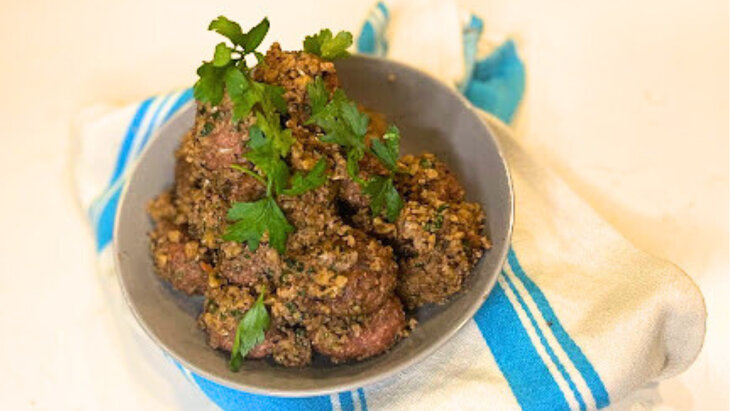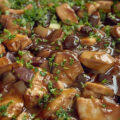Every year at Hanukkah time, millions of Jewish homes are graced with the sweet aroma of freshly baked Sufganiyot (Jewish Jelly Doughnuts), crispy Latkes and chocolate gelt.
To accompany these Holiday guilty pleasures we recall the story of the small jar of oil that lasted 8 days, we read and sing about the Maccabees who waged war on the ancient Greeks to defend their country and came out improbably victorious.
What we don't hear much about is the Jewish Greeks. We don't hear their stories or partake in their sweets and pastries. And by missing out on that, we are letting a rich culture of food, history and tradition go by the wayside.
Who, What, Where and Why?
There has been a Jewish population in Greece since at least the fourth century B.C.E. Making it the earliest Jewish community to exist in Europe.
However, the Greek Jewish community only started to grow dramatically in the 14th century. When a wave of Ashkenazi immigrants fled Hungary and Germany to avoid the persecution of Jews throughout the 15th century. The majority of the Jews then settled in Athens and Thessaloniki and established bustling Jewish neighborhoods there.
While originally practicing their own traditions and customs. In the 15th century the demographics of the Greek Jews changed drastically.
Suddenly, tens of thousands of Sephardi Jews were refugees due to the Spanish Inquisition.
Desperate for a place to live in peace they found a safe haven in Greece, particularly in the city of Thessaloniki.

Since many were experienced merchants and craftsmen, Sultan Bayezid II welcomed them with open arms, regarding them as a valuable addition to Thessaloniki’s labor force. By 1553, the city had become a leading Jewish center of Europe, with around 20,000 Jewish residents.
Over time, the Sephardi Jewish tradition and practices of the newcomers came to overshadow the original customs. The influx of Sephardim not only impacted the demographics of the city but also the cuisine.
The vibrant Greek cuisine filled with fresh vegetables and leafy greens had been infiltrated with the rich flavors and spices of the Spanish newcomers.
Additionally, the Sephardim introduced their own customs and practices, as well as their own language, a Judeo-Spanish hybrid called “Ladino” that is still spoken today.
Feta Late Than Never
Being a port city, Thessaloniki's proximity to the water made it a prime location for fresh produce, fish and meats. Which inevitably made their way into the dietary staples of the Jewish community.
What makes Greek Sephardi food so unique isn't just the fusion of the two cuisines and cultures but also their vastly different techniques and ingredients.
We're going to take a look at a few of the most important and delicious recipes that were popularized in Thessaloniki in the Jewish community. And what makes them so special.
Borrekitas De Merendjéna, roughly translated to small eggplant pies is a famous Greek staple that could've been found in many the Jewish household in the 1500's.
By filling a Spanish style empanada with eggplant, a staple of Mediterranean cuisine we are left with a special combination of flavors and textures that you need to try at home.
Another Greek classic amongst the Jewish community was Keftikés De Nogáda Con Muési Prishil AKA Meatballs with walnuts and parsley.
Because of course every cuisine has to have their own take on meatballs. These tasty croquettes figure prominently in Thessalonian Sephardic cuisine usually served in a thick & creamy walnut sauce.
Another one of the most recognizable remnants of Greek Sephardi cuisine can be seen in the streets of Israel to this day. On friday mornings, world cup matches or holidays you can find retirees eating boiled or roasted Fava beans and reminiscing of old times at the local hummuserias or coffee shops.

Anyone who's visited Greece can attest to there being no shortage of Loukoumades shops.

Almost as if there were some unwritten Greek rule requiring each tourist street to have one. During Hanukkah time Greek Jews would frequently make these tasty treats. Similar to Sufganiyot, they are fried balls of sweet dough. However, loukoumades differ in that they only rise once and are coated in a light honey drizzle. A Greek specialty.
What Now?
Nearly 90% of the Greek Jews were wiped out in the Holocaust. Leaving just 5,000 Jews in Greece today. With precious few left to tell their story, the Jewish people of Thessaloniki's culture and recipes faded almost entirely into oblivion.
Just like the miracles of Hanukkah and Ancient Greece are remembered each year through the food we eat and stories we tell. We should make an effort to remember the history of the strong Jewish community in Greece, their recipes and customs and the sacrifices of those who perished in the Holocaust.
Happy Hanukkah!








 Loukamades - Get the recipe
Loukamades - Get the recipe











What about the enhaminados eggs. A holocaust survivor used to sell them in Thessaloniki in his little store until he died. Nobody replaced him. Citizens from all around Thessaloniki used to buy the eggs, mostly for special dinners.
Thank you for the history lesson.
OY! Your history is not correct at all. Many of these dishes were in fact from the influx of Spanish and Portuguese Jews who flooded the area after the Inquisition (1500's). My family is of Spanish and Portuguese descent and we ended up in Turkey (Izmir) and make the exact same dishes or very similar. Yes, the Greeks have a very long and robust history, but all of the dishes you cite are in fact Spanish and Portuguese and the names come from Ladino, not Greek. I have many Sephardic Cookbooks showing these recipes, that they are in fact of Spanish and Portuguese origin and will gladly share the information.
S. Amiel you need to read this article again. The Sephardim from Spain and Portugal are given full credit for everything they brought to Greece including the food and the Ladino language. I read the article but you seemed to not have done so quite thoroughly enough. Kindly do and you'll be pleased.
p.s. to S. Amiel, read all the paragraphs under the section "Who, What, Where and Why" until the next section of "Feta Late Than Never."